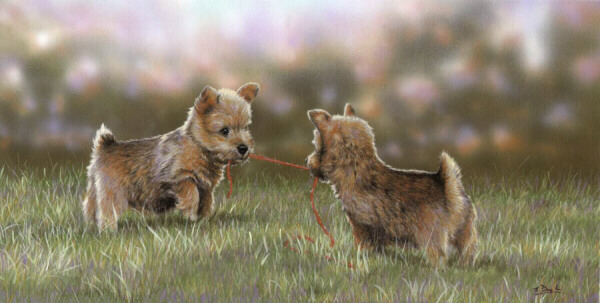
Until 1964, Norwich Terriers and Norfolk Terriers were considered to be one breed, and the two share a common history in the names by which they were known “back in the day.”
Today, the names of both breeds refer to their place of origin, the East Anglia town of Norwich in the county of Norfolk that lies just north of London, but early ancestors of the Norwich and Norfolk Terriers (remember now, they were regarded as one breed) were known as the Cantab, Trumpington, and Jones Terrier.
Why those names?
With the exception of the Cantab Terrier, early names make sense once you have a little bit of information.
In the 19th century, so many undergraduates of Cambridge University kept these dogs in their dorms to combat rat infestations that the dogs eventually became the official mascot of the University. Stories conflict about whether Trumpington refers to the street on which most of these students lived (Trumpington Street is still around today and is an arterial road in southeast central Cambridge), or whether the name comes from the livery stable that was situated on Trumpington Street, the place where the students bought their dogs. Either way, we can almost hear you think, “Ohhhhh, that explains the Trumpington Terrier name.”
Jones Terrier is equally sensical when you learn that in 1914, a descendent of one of the Trumpington Terriers was acquired by a Brit named Frank “Roughrider” Jones who would come to breed a dog named “Willum.” Willum was exported to Philadelphia and became the breed’s foundation sire in the United States. Roughrider Jones was so intimately associated with these delightful terriers that the breed came to be known among American fanciers as the “Jones Terrier.” Even after the breed was recognized by the English and American kennel clubs in the 1930s as the Norwich Terrier, devotees of the dogs referred to their little canines as Jones Terriers.
Another “aha” moment.
Murkier, however, is the source of the name, “Cantab Terrier.” There was no street named Cantab, nor any person associated with the development of the breed by that name. Most sources simply say that because the dogs were so favored by Cambridge University undergraduates, the dogs came to be known as “Cantab Terriers,” but what is a “Cantab?”
One hint comes from the city seal for Cambridge, Massachusetts where the name, “Cantabrigia” appears. The word also appears on the seal of the Episcopal Divinity School also based in Cambridge, Massachusetts. Digging a little deeper, we learned that Cantabrigia is the medieval Latin name for Cambridge created on the basis of the Anglo-Saxon name, Cantebrigge.
Stay with us here. You know those letters that appear after a person’s name to indicate their academic degree, military decoration or accreditation? Those are called “post nominal suffixes.” “Cantabrigiensis” was the “post nominal suffix” that indicated a degree from the University of Cambridge. Cantabrigian became a word used to refer to Cambridge University and its students, and the word was always shortened to “Cantab.” Once you know that Cambridge University students were referred to as “cantabs,” you can make the connection between them and the dog they favored.
As an aside, the word, “Cantab” was still being used fairly recently. It was the name of the magazine produced by students at the University of Cambridge for nearly a decade between 1981 and 1990.
And now you know.
Image: “Tug of Love” by Paul Doyle
https://www.facebook.com/PaulDoyleArt

My breed. Love these little terriers!!!
There isn’t much not to love about them, Lyn. Fabulous little dogs!
From Joan Read’s seminal book, The Norfolk Terrier, “The most famous dog man of the day was Charles “Doggy” Lawrence of nearby Chesterton, who bred terriers, horses, and game fowl. Said to use small Irish, Yorkshire, and native East Anglian red terriers (“gypsy dogs”), Lawrence developed his so-called Cantabs as student companions and ratters … There are various conjectures regarding the ingredients of the Cantab strain.According to one theory small red terriers accompanied Irish gypsies, who were said to spend part of each year in or around Norfolk. An observer described these short-egged terriers as ‘devils to poach’
And Norwich and Norfolk are qite different. Perhaps Joan said it best when she wrote: Norfolks are more apt to suffer from jealousy than Norwich and they frequently become hunting or racing addicts with great powers of consentration. Norwich adapt more easily to urban life, preferring the company of humans over other dogs. Norfolks are more ‘back to nature,’ easier to breed, and more independent. Norfolk tails quiver and Norwich tails wag. (Joan was one of the earliest breeders of Norwich, Norfolk, and Labradors in this country. We lost her in 1995 but her legacy lives on. Her kennel name was Chidley)
Thanks for the recommendation, Sheila. We don’t doubt that today, the breeds are quite different from each other, our post having to do with early names for the breed at a time they was considered to be the same breed. Ms. Read’s descriptions are quite delightful, and we appreciate you sharing them with us!